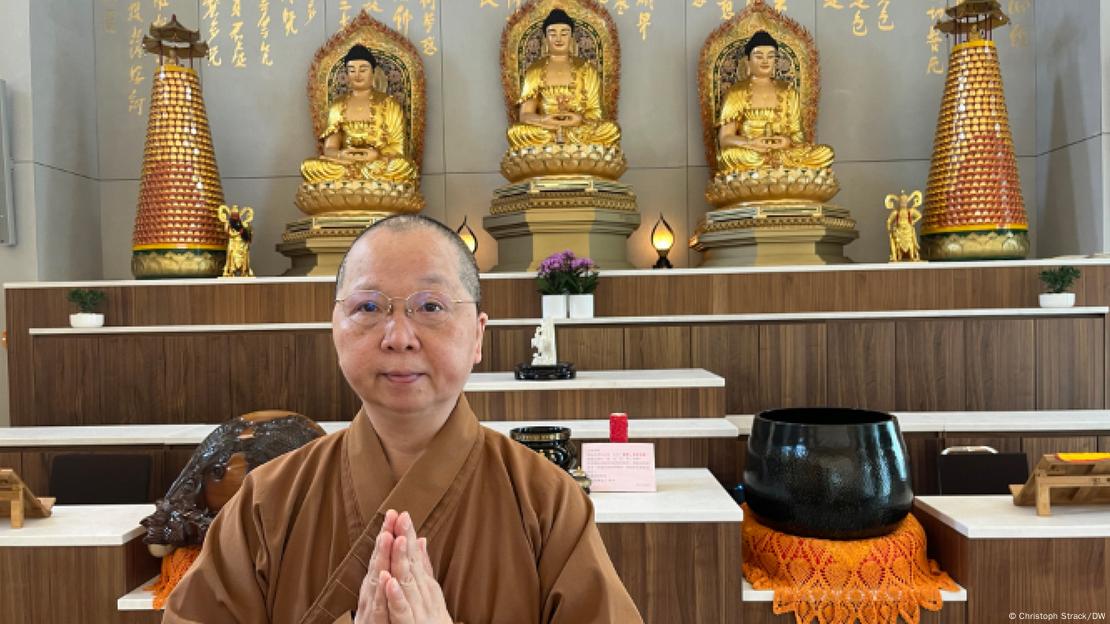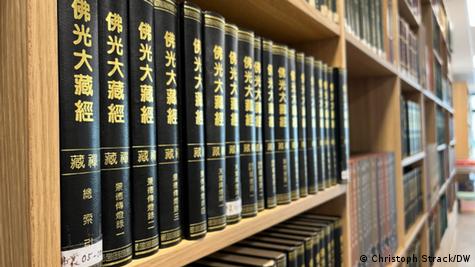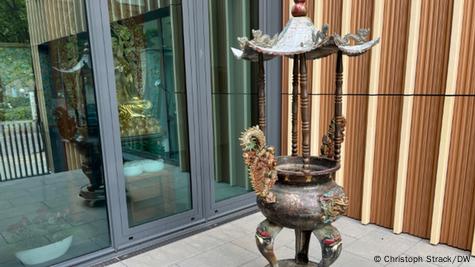DW
Germany's newest Buddhist temple has opened in Berlin. It will be home to a small but very international religious community.
Germany's newest Buddhist temple opens in Berlin on Sunday
Image: Christoph Strack/DW
This particular street in central Berlin looks as if it has been overlooked by the gentrification elsewhere in the district. A few rather shabby apartment buildings, a car repair shop, a high-rise at the end of a cul-de-sac with a daycare center. A place where construction waste, smashed toilet bowls, empty paint buckets, and other junk are regularly and illegally dumped at night.
Yet this section of Ackerstrasse, barely two kilometers (1.2 miles) from Olaf Scholz's chancellery, is also home to a new building, seven years in construction, that happens to be one of the most remarkable religious buildings in the German capital: A modern Buddhist temple.
Miaoshiang Shih is the master of the Fo Guang Shan Community Temple. Born in Taiwan, she has been living in Berlin for decades, and for over 30 years has been meditating at the same place on Ackerstrasse with two or three other nuns in a wooden shack that used to be an auto parts factory. The nuns lived in an apartment next door.
The Buddhas have to make way
The friendly Buddhist with the shaved head leads a tour through the new building, showing off the rooms with pride: The main hall of the temple, where morning and evening meditation will be held in front of the three golden Buddhas, plus the kitchen, the guest rooms, the dining room, rooms for art exhibitions or small concerts, and a small memorial hall for the deceased.

Miaoshiang Shih is the master of the Fo Guang Shan Community TempleImage: Christoph Strack/DW
The master elaborates on the artfully crafted metal structure in front of the building. This, she tells DW, "is the incense stand. It's not allowed in the building because of fire safety regulations."
The temple was built without any financial support from the government. Everyone here on the team is familiar with the fire safety and building codes. As for the cost of the temple, Miaoshiang Shi remains discreet — she does say, however, that the construction was four times more expensive than calculated. Buddhist monasteries and Fo Guang Shan practitioners from all over the world helped to cover the costs.
Worldwide network
The monastery is part of the Fo Guang Shan community, which was founded in Taiwan in 1967. The name means "Buddha's Mountain of Light" in Chinese, and there are many such monasteries in Taiwan and around the world, including in a number of major European cities. In Germany, a monastery was opened in Frankfurt in 2004. Shi emphasized that there are also several monasteries in mainland China, and among the Asian members who come to Ackerstrasse to meditate, there are also many from China.
"At our center, humanistic Buddhism is our guiding principle," said the master. This modern Buddhist philosophy combines the meditative practice of Zen with a deliberate closeness to people. The teachings encourage people to care for others. On Sundays, Ackerstrasse also offers lunch and everyday care for those in need.
The master elaborates on the artfully crafted metal structure in front of the building. This, she tells DW, "is the incense stand. It's not allowed in the building because of fire safety regulations."
The temple was built without any financial support from the government. Everyone here on the team is familiar with the fire safety and building codes. As for the cost of the temple, Miaoshiang Shi remains discreet — she does say, however, that the construction was four times more expensive than calculated. Buddhist monasteries and Fo Guang Shan practitioners from all over the world helped to cover the costs.
Worldwide network
The monastery is part of the Fo Guang Shan community, which was founded in Taiwan in 1967. The name means "Buddha's Mountain of Light" in Chinese, and there are many such monasteries in Taiwan and around the world, including in a number of major European cities. In Germany, a monastery was opened in Frankfurt in 2004. Shi emphasized that there are also several monasteries in mainland China, and among the Asian members who come to Ackerstrasse to meditate, there are also many from China.
"At our center, humanistic Buddhism is our guiding principle," said the master. This modern Buddhist philosophy combines the meditative practice of Zen with a deliberate closeness to people. The teachings encourage people to care for others. On Sundays, Ackerstrasse also offers lunch and everyday care for those in need.

Several texts now need translating into English
Image: Christoph Strack/DW
The new Buddhist temple fits in well in Berlin. With more than 3.5 million people, the capital is not especially religious. But it is known for its religious diversity. According to estimates on the website of the state's Department for Culture and Social Cohesion, there are more than 250 religious or ideological communities active in Berlin, who play an "important role in the social life of this multicultural metropolis." The Ackerstrasse building is by no means the only Buddhist institution in the city. The Buddhist House in Frohnau, in northern Berlin, is already over 100 years old.
Religious diversity in Berlin
As more young people from around the world come to Berlin to study or work, the city is becoming more diverse. Later this year, a Hindu temple that has been under construction for almost 20 years is due to open in the south of the city.
And at the end of November, the Catholic Church plans to reopen its St. Hedwig Cathedral on central Bebelplatz for worship after four years of renovation. Construction on the House of One, a joint project of Christians, Jews, and Muslims, is behind schedule. Smaller non-denominational churches, synagogues, and mosques are also springing up at the same time.
This fits in with the picture that Miao Shiang Shi paints of the visitors and supporters of the monastery. She described passers-by popping into the building, or school classes who want to get to know the building. Among the members of the community are also some long-time Berliners. But the guests are becoming more and more international.
The new Buddhist temple fits in well in Berlin. With more than 3.5 million people, the capital is not especially religious. But it is known for its religious diversity. According to estimates on the website of the state's Department for Culture and Social Cohesion, there are more than 250 religious or ideological communities active in Berlin, who play an "important role in the social life of this multicultural metropolis." The Ackerstrasse building is by no means the only Buddhist institution in the city. The Buddhist House in Frohnau, in northern Berlin, is already over 100 years old.
Religious diversity in Berlin
As more young people from around the world come to Berlin to study or work, the city is becoming more diverse. Later this year, a Hindu temple that has been under construction for almost 20 years is due to open in the south of the city.
And at the end of November, the Catholic Church plans to reopen its St. Hedwig Cathedral on central Bebelplatz for worship after four years of renovation. Construction on the House of One, a joint project of Christians, Jews, and Muslims, is behind schedule. Smaller non-denominational churches, synagogues, and mosques are also springing up at the same time.
This fits in with the picture that Miao Shiang Shi paints of the visitors and supporters of the monastery. She described passers-by popping into the building, or school classes who want to get to know the building. Among the members of the community are also some long-time Berliners. But the guests are becoming more and more international.

The new temple is officially called the Fo-Guang-Shan
Image: Christoph Strack/DW
For a long time, the nuns struggled to translate their liturgical and spiritual texts from Chinese into German. Now the demand for texts in English is growing. There have been temple visitors from South Africa and Indonesia. And an Indian scientist who got to know the monastery finally ended up coming to Ackerstrasse every week, eventually translating texts into English. "He has become a kind of family member for us," says the master.
Sunday, June 23 will be an exceptionally international day. The small community of nuns, two from Taiwan and one from Singapore, is expecting the highest-ranking abbot of the order to attend the opening ceremonies, along with a few companions from Taiwan and all the masters of the Buddhist monasteries in Europe, approximately three dozen representatives. In total, Shi expects up to 600 guests, far too many to fit into the temple space itself.
But the master is delighted. She says that the guests will be seated in the small Chinese garden that has been newly created at the back of the building. There, under a large picture of Buddha on the façade of the building, people will fill the rows of seats for the first time and watch the celebrations on large screens.
This article was originally written in German.
For a long time, the nuns struggled to translate their liturgical and spiritual texts from Chinese into German. Now the demand for texts in English is growing. There have been temple visitors from South Africa and Indonesia. And an Indian scientist who got to know the monastery finally ended up coming to Ackerstrasse every week, eventually translating texts into English. "He has become a kind of family member for us," says the master.
Sunday, June 23 will be an exceptionally international day. The small community of nuns, two from Taiwan and one from Singapore, is expecting the highest-ranking abbot of the order to attend the opening ceremonies, along with a few companions from Taiwan and all the masters of the Buddhist monasteries in Europe, approximately three dozen representatives. In total, Shi expects up to 600 guests, far too many to fit into the temple space itself.
But the master is delighted. She says that the guests will be seated in the small Chinese garden that has been newly created at the back of the building. There, under a large picture of Buddha on the façade of the building, people will fill the rows of seats for the first time and watch the celebrations on large screens.
This article was originally written in German.

No comments:
Post a Comment